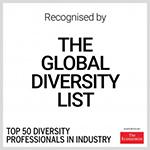Digging Deeper into the Diversity Agenda
By Sarojani Gaikwad, Director – People Business
The rapid growth of global organizations in the Asia Pacific region, are driving firms to expand their workforce, and make space for a diverse employee set. In the recent decades, organizations have done substantial work in the area of gender diversity and inclusion, discovering personal, social, cultural and structural challenges. CEO’s are also under pressure to bring in more women leaders into the boardroom and move the needle from just a mere 9 % population (McKinsey & Company, Women Matter Asia, 2012). Catalyst 2014 Survey also shared that companies with the highest representation of women on their top management teams experienced better financial performance (Return on Equity and Total Return to Shareholders) than group of companies with the lowest women representation. Yet firms are experiencing a leaking pipeline, forming a lopsided pyramid.
Research has identified critical challenges that women face as they try to move up the pyramid like struggles with cultural /attitudinal stereotypes, the much discussed double bind, the juggle between work and family, and very few role models to look up too. But somehow the problem seems deeper, arising from the social fabric of our cultures. A Global Human Resource Director Asia Pacific shared her experiences of gender diversity where the social roles of women overpowered the organization centric role. For example, in a team meeting, when the food was rolled in, it was always the women (how ever senior) who would get up to serve. In other parts of the region, women around the table would be silent in a team meeting, and the one who spoke would have to deal with piercing and awkward looks. There is a need for organizations to work with socially perceived roles, and unconscious biases that penetrate the corporate culture becoming a barrier for retaining women especially at senior levels (Cherry, 2011; Davies, 2011).
Here are some ways organizations can begin to understand and dwell on this challenge more meaningfully-
Defining your ‘Real’ reason: It is important that organizations understand why they want to tread this path, and what are they willing to commit to and change to make a real impact. The struggle is when global organizations push the diversity agenda from the head quarters, but local organizations struggle to convince the leadership team to shift focus. There is a need to realise that diversity is no longer a compliance issue but really impacts business numbers (Ernst & Young 2012). It is observed that when organizations have one gender more than the other, the cultural attributes swing with the dominant gender this can be pretty scary for the weaker voices in the firm (Jackson, 2001).
Diversity expands itself beyond just the visible gender differences, to allowing the organization to experience the invisible differences in thoughts and ideas. A diverse workforce encourages different worldviews, where all around, the table appreciate the difference and leverage the same to provide a more enriched business solution. It allows us to challenge our ways of thinking and working, truly valuing and appreciating each other, not just valuing people who look just like us.
It is also important to define the governance model – who is really accountable? What are the measures? What are the different roles to ensure success? The worse impact on diversity is an extravagant communication, with a weak experience, confusing the target audience and revealing an inauthentic employer. Organizations are now building a diversity taskforce to drive the agenda and bring it to life through cultural and systemic changes.
Torch Bearers at the Top: Imagine working for a CEO that calls his direct reports for a review meeting at 11 PM which extends into the early hours of the morning. He simply communicates a message of how one can’t have a life other than working for him, which is tough for men and women. “Improving gender balance requires personal commitment from the CEO and Board. Without this real progress won’t happen” (Chief Executive Women 2009).
A leader communicates much more while he makes decisions and while he deals with his people, than his speech in an ‘All Hands Meet’. People watch and decide whether he is only going by the book or truly believes in what he is saying. It is important for the CEO and top management leaders to first understand what are the unconscious biases and behaviours hindering the attraction and retention of women leaders. If employees don’t see their leaders believing in the diversity agenda and living the talk, they will know that it is just another fad that will soon pass away. An international bank based in India, worked with its leaders to unearth the unconscious bias that was reflected in day to day dealings and yet this was just scratching the tip of the iceberg. Some organizations spend a year just building awareness on unconscious biases and how they impact decisions especially while recruiting or assessing performance.
Systemic Approach: Organizations will need to align the diversity agenda to the Employee Value Proposition, activating it across each employee process. They also need to have a hard look at what are the structural organizational barriers – policies, norms of working which could be a hindrance.
Firms are relooking at the recruitment processes- altering language that could be more masculine reflected in the job description or just ensuring that a woman is present on the panel. Today firms are identifying high potential women leaders, investing in customised development and mentoring over a period of time. In 2011, we worked with a UK based bank, who identified 15 high potential mid level women leaders in the India office, assessed and developed them on critical leadership competencies over a six months program, helping them focus and overcome challenges they were facing personally as well as structurally. We also engaged with their manager who were predominantly men, helping them understand how they could encourage and support these leaders to move into larger senior level roles. Another global organization prepares women leaders in the Asia Pacific region for regional leadership roles, through a nine month ‘Leadership Transformation Program’, building individual leadership and business skills. We help these women accept their leadership identity, engage in moments of conflict and work to strengthen strategic and business acumen. The regional MD himself closely monitors the progress along with the People Business Coach, ensuring that the leader get the required support needed to succeed on the program.
We also believe that measuring and monitoring critical diversity metrics makes it an even more serious business, asking key questions like, how is the talent strategy aligned to the diversity agenda? Are we recruiting enough women? How many are being promoted? How many women are in our leadership pipeline? How engaged are the women workforce? Organizations are even ensuring that these metrics show up in the performance scorecards holding employees accountable to executing the plan.
As organisations, we will need to build spaces where individuals thrive and celebrate their uniqueness impacting the business success. It goes beyond just accepting or aligning with individuals differences, it is about consciously embracing the difference bringing out the very best. Diversity starts with each of us, being aware of how we respond to people who are unlike us, are we willing to listen or solicit a different opinion, and are we inclusive to ensure equal access. Diversity doesn’t begin from the organization but starts right from our core – our minds and actions.
The author Sarojani Gaikwad, Director – People Business, has extensive leadership experience in creating and delivering integrated, high-impact solutions in all aspects of people management. She works with organizations to institutionalize a people development agenda, which demands mindset shifts in individuals and cultures. She believes that cultures need to be ‘consciously defined and works to build cultural elements that strengthen every people interface. Sarojani, a leadership coach, culture enthusiast and employer branding evangelist, works with various cultures across global markets delivering on critical consulting assignments that impact business outcomes.











